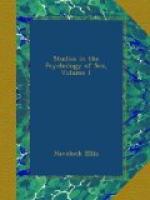[380] Selden’s Uxor Hebraica as quoted in Gibbon’s Decline and Fall, vol. v, p. 52, of Bonn’s edition.
[381] I may add that the curve yielded by 1896-97 is remarkably parallel with that yielded by the preceding nine years, but I have not thought it worth while to chart these two additional curves.
[382] See “Rhythm of the Pulse,” Chart 4.
[383] As will be observed, I have omitted the results of the incompletely recorded years of 1889 and 1891. The apparent explanation of this curious oscillation will be given directly.
[384] See “Rhythm of the Pulse,” p. 21.
APPENDIX C.
THE AUTO-EROTIC FACTOR IN RELIGION.
The intimate association between the emotions of love and religion is well known to all those who are habitually brought into close contact with the phenomena of the religious life. Love and religion are the two most volcanic emotions to which the human organism is liable, and it is not surprising that, when there is a disturbance in one of these spheres, the vibrations should readily extend to the other. Nor is it surprising that the two emotions should have a dynamic relation to each other, and that the auto-erotic impulse, being the more primitive and fundamental of the two impulses, should be able to pass its unexpended energy over to the religious emotion, there to find the expansion hitherto denied it, the love of the human becoming the love of the divine.
“I was not good enough
for man,
And so am given to God.”
Even when there is absolute physical suppression on the sexual side, it seems probable that thereby a greater intensity of spiritual fervor is caused. Many eminent thinkers seem to have been without sexual desire.
It is a noteworthy and significant fact that the age of love is also the age of conversion. Starbuck, for instance, in his very elaborate study of the psychology of conversion shows that the majority of conversions take place during the period of adolescence; that is, from the age of puberty to about 24 or 25.[385]
It would be easy to bring forward a long series of observations, from the most various points of view, to show the wide recognition of this close affinity between the sexual and the religious emotions. It is probable, as Hahn points out, that the connection between sexual suppression and religious rites, which we may trace at the very beginning of culture, was due to an instinctive impulse to heighten rather than abolish the sexual element. Early religious rites were largely sexual and orgiastic because they were largely an appeal to the generative forces of Nature to exhibit a beneficial productiveness. Among happily married people, as Hahn remarks, the sexual emotions rapidly give place to the cares and anxieties involved in supporting children; but when the exercise of the sexual function is prevented by celibacy, or




